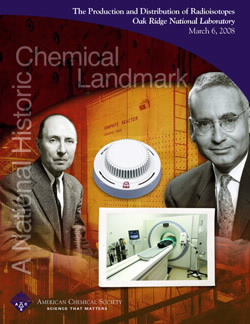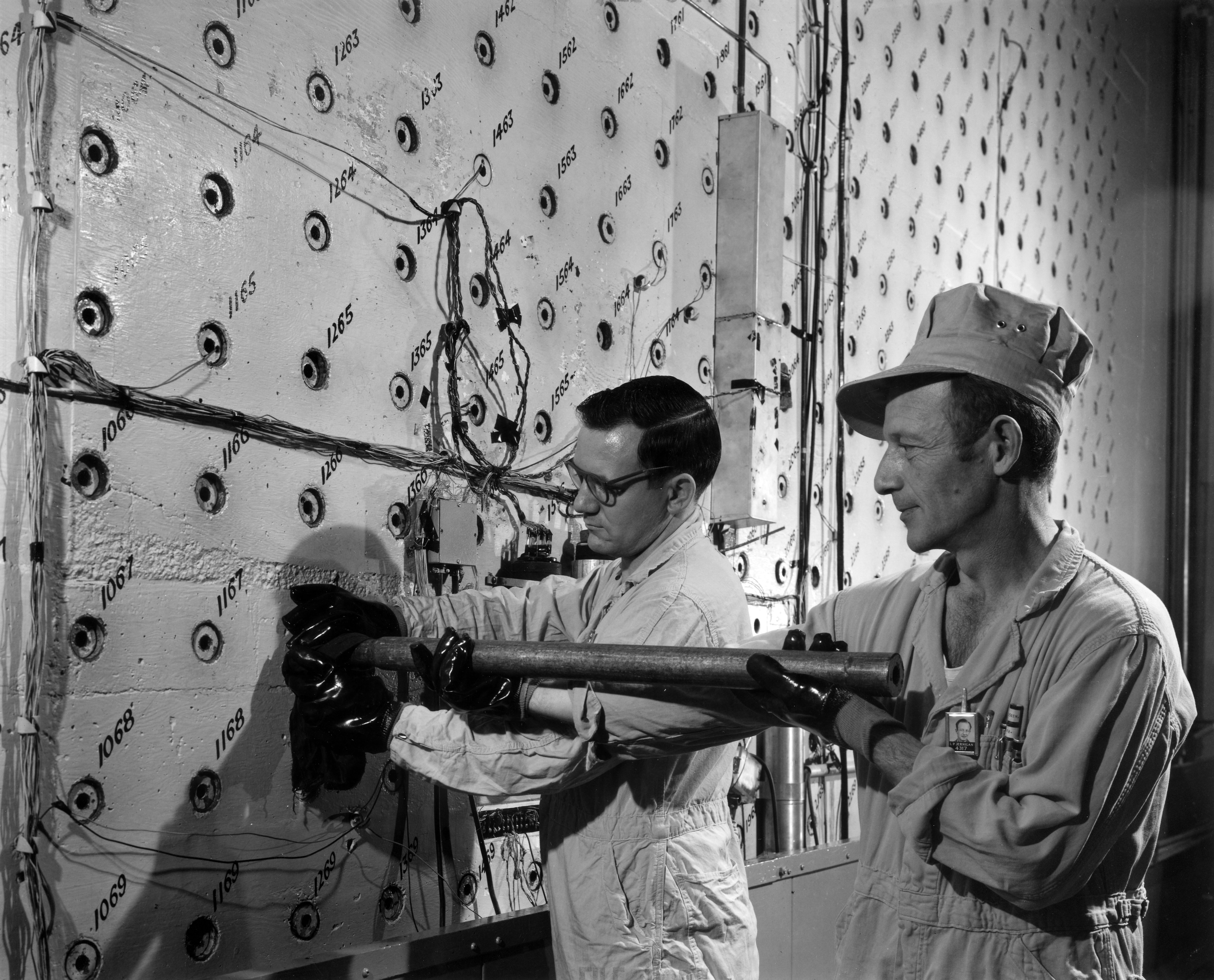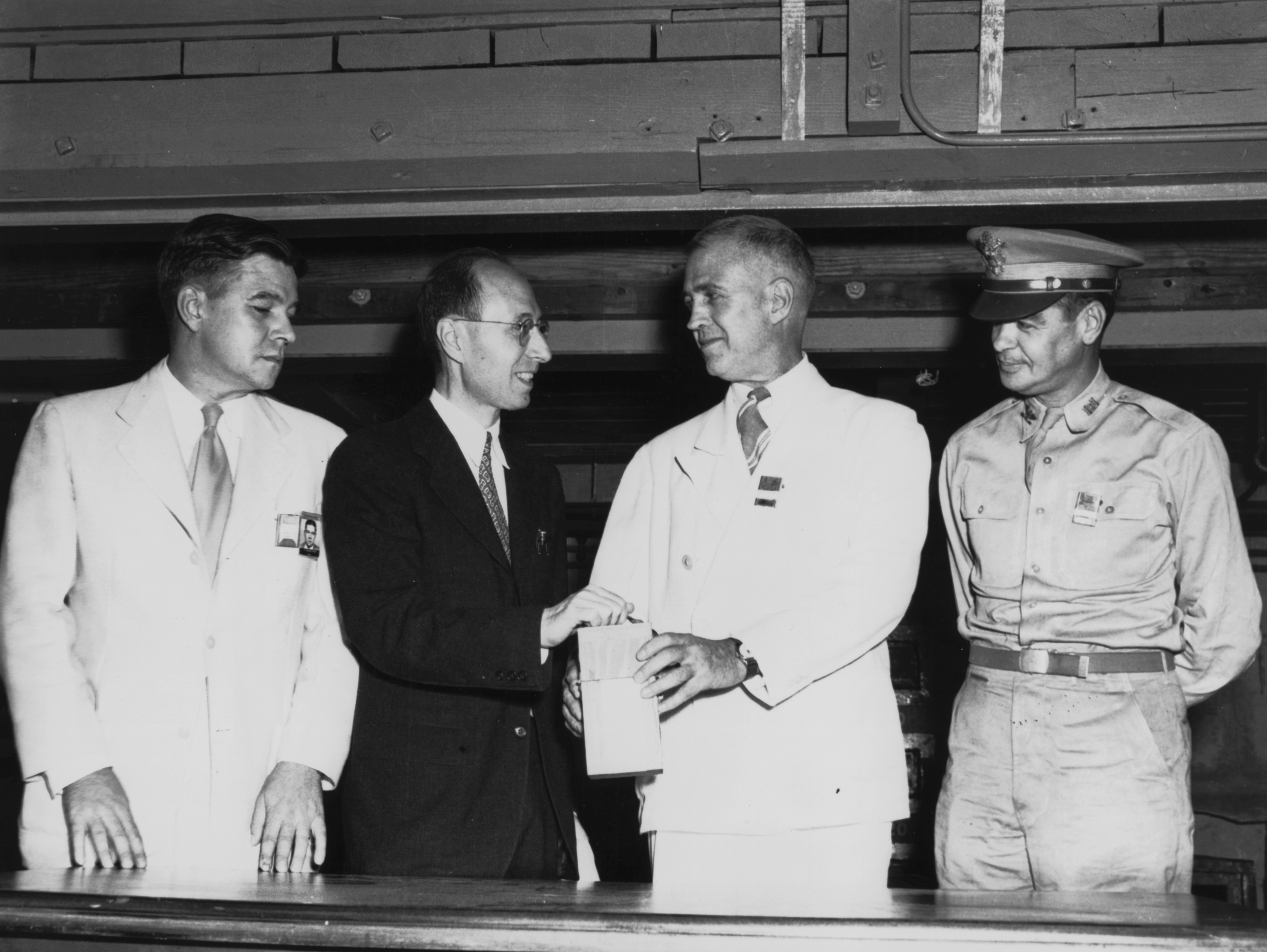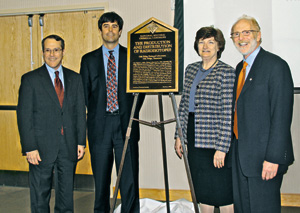Production and Distribution of Radioisotopes at ORNL
Dedicated March 6, 2008, at the Oak Ridge National Laboratory in Oak Ridge, Tennessee.
Conceived in wartime, Oak Ridge National Laboratory (ORNL) managed the transition to peacetime, in part, through the production and distribution of radioisotopes, perhaps the most important scientific byproduct of the Manhattan Project. These radioactive forms of chemical elements have a myriad of medical, industrial, and agricultural uses. The availability of radioisotopes led to advances in chemistry, biochemistry, molecular biology, and many other applied and theoretical sciences.
Contents
- 1945: Uncertain Future for Oak Ridge National Laboratory
- Origins of the Manhattan Project and Oak Ridge National Laboratory
- Atomic Energy in Peacetime: Radioisotope Production for Science and Medicine
- Nuclear Medicine: Radiographic Imaging and Radiotherapy
- Uses of Radioisotopes
- Further Reading
- Landmark Designation and Acknowledgments
- Cite this Page
1945: Uncertain Future for Oak Ridge National Laboratory
August 1945: The United States drops two atomic bombs on Japan, the culmination of the wartime Manhattan Project. Faced with the prospect of further unprecedented and unimaginable destruction, Imperial Japan surrenders.
In eastern Tennessee, the staff at Clinton Laboratories (now Oak Ridge National Laboratory), proud of its contribution to the war effort and, like all Americans, relieved the war is over, understandably faces the future with anxiety. Would the federal government fund peacetime atomic research? Would it, in other words, invest in the peaceful uses of nuclear energy at levels remotely approaching the investment in weapons production? Would the scientists, caught up in the fervor of the war years, stay in the rural hills of eastern Tennessee instead of returning to universities and research laboratories? Were there even peacetime uses for their laboratory? As Alvin Weinberg, later the facility’s director for many years, said: “During those days immediately after the war, everything seemed ambiguous.”
One of those who thought the laboratory had a future was Eugene Wigner, one of the legendary refugee scientists from Fascist Europe who provided the theoretical and practical knowledge that fueled the Manhattan project. Wigner became director of research and development at Clinton Laboratories in 1946, but as early as 1944 he had drawn up plans for a postwar facility with a staff of about 3,500 devoted to nuclear research.
—Alvin Weinberg, Director, Oak Ridge National Laboratory, 1955-1973.
Origins of the Manhattan Project and Oak Ridge National Laboratory
The story behind the decision of President Franklin Roosevelt to develop the atomic bomb is well known. The decision grew out of fear on the part of a number of scientists that Nazi Germany might develop the bomb first. Many of these scientists had fled fascism; among them were Albert Einstein from Germany, Enrico Fermi from Italy, and Edward Teller, Leo Szilard, John von Neumann, and Eugene Wigner, all from Hungary. Wigner, who has been called the “patron saint” of Oak Ridge National Laboratory, teamed with Szilard in 1939 to enlist Einstein, the most famous scientist of the first half of the twentieth century and the one Washington officials most likely would heed, to help persuade the U.S. government of the danger. In July, 1939, Wigner and Szilard tracked Einstein down in his vacation cabin on Long Island, explaining to him why the United States should undertake nuclear research before German scientists developed an atomic bomb. Wigner later said Einstein readily understood the significance of what he was told and immediately dictated a letter to President Franklin Roosevelt.
The letter persuaded Roosevelt; he appointed a committee of prominent scientists and government researchers to manage federally funded scientific research. Then, in mid-1942, Roosevelt assigned a unit of the U.S. Army Corp of Engineers, headquartered near New York’s City Hall in Manhattan, to coordinate nuclear weapons research. General Leslie Groves, named commander of the project in 1942, worried the project’s original name, “Laboratory for the Development of Substitute Materials,” might draw undue attention; accordingly, he dubbed it the “Manhattan Engineer District,” soon shortened to the “Manhattan Project.” Research and production took place at a number of sites, with Clinton Laboratories commissioned to produce and isolate gram quantities of plutonium.
The history of Oak Ridge National Laboratory (ORNL) is linked with that of another project: The Tennessee Valley Authority. ORNL and TVA share a common geography—East Tennessee—and a common political heritage as large, government-sponsored projects of the Roosevelt administration. At first glance, East Tennessee did not seem a propitious site for a war-related facility: The region had very few scientists and no sophisticated laboratory equipment. But it did have cheap and abundant electricity, thanks to TVA, and its isolation proved a plus because the top-secret facility would be located far from prying eyes. In 1942, a site bordering the Clinch River between the small towns of Clinton and Kingston was selected. The area was served by two railroads in addition to TVA. About one-thousand families were paid for their land and forced to relocate.
Since speed was critical, Groves selected experienced industrial contractors to build and operate the Manhattan Project’s facilities. He granted DuPont the contract to construct the pilot plant in Tennessee and the full-scale reactors later built in Hanford, Washington. Accordingly, on February 1, 1943, construction began on the world’s first operational nuclear reactor, known as the “Clinton Pile,” or the Graphite Reactor. It took only nine months to build the pile, which became critical on November 4, (the first experimental nuclear reactor, which produced the first sustained nuclear reaction, had been built the year before in Chicago by Enrico Fermi and his colleagues).
The goal of the Clinton facility, code-named X-10, was to bombard uranium-238 with neutrons to produce plutonium for developing a nuclear weapon. As such, X-10 was a demonstration plant for the production of plutonium from uranium. Eventually, other facilities built on the pilot work done at Clinton to produce the plutonium used in the atomic bomb dropped on Nagasaki, Japan.
Atomic Energy in Peacetime: Radioisotope Production for Science and Medicine
The production and distribution of radioisotopes became part of the answer to the question of what would happen after the end of World War II to Clinton Laboratories, which fell under the purview of the Atomic Energy Commission (AEC), created in 1946 to oversee the transfer of atomic energy from military to civilian control. In 1947, the AEC changed the name to Clinton National Laboratory (in 1948 the named changed again, to Oak Ridge National Laboratory). More importantly, the AEC decided to utilize the existing Graphite Reactor at Clinton and to take advantage of the facility’s scientific knowledge by maintaining it as a center for basic and applied chemical research and for isotope research and production.
The peacetime production of radioisotopes at the Graphite Reactor began in 1946 under the aegis of Waldo Cohn, representing the Laboratory, and Paul Aebersold of the AEC. On June 14, 1946, before the AEC became operational, the laboratory published in Science magazine a catalogue of reactor-produced isotopes that Clinton could prepare and distribute for scientific and medical uses. The list included almost twenty fission-produced isotopes and about sixty non-fission products available to qualified researchers. On August 2 Eugene Wigner, standing in front of the Graphite Reactor, presented a small container of carbon-14 to the director of the Barnard Free Skin and Cancer Hospital of St. Louis. That presentation marked the beginning of the peacetime uses of atomic energy.
In the first year of production, Clinton made more than a thousand shipments of radioisotopes, mostly of iodine-131, phosphorus-32, and carbon-14; by 1950, the number of shipments neared 20,000. After the closing of the Graphite Reactor in 1963, production shifted to the Oak Ridge Research Reactor, which produced radioisotopes until 1987. Today, most radioisotopes are made outside the United States, but ORNL continues to produce specialty isotopes at its High Flux Isotope Reactor, which centers on the development of new radiopharmaceuticals and radioisotope generators for diagnosis and treatment of human diseases, including various cancers and heart ailments.
Nuclear Medicine: Radiographic Imaging and Radiotherapy
Nuclear medicine began in the 1930s when physicians experimented with radioisotopes to treat diseases such as lymphoma and thyroid disorders. Today, more than ten million therapeutic procedures using radioisotopes (“nuclear medicine” procedures) are performed on patients in the United States every year and more than 100 million nuclear medicine diagnostic tests are conducted on Americans annually.
For most people, it is nuclear medicine that demonstrates the usefulness of radioisotopes. Nuclear medicine uses radiation to provide information about the functioning of an individual’s organs or to treat disease. The thyroid, bones, heart, liver, and many other organs can easily be imaged, revealing disorders in their functioning. In some cases, radiation is then used to treat diseased organs or to shrink or eliminate tumors.
As many as one hundred radioisotopes are used in diagnosis or therapy. Over the years, radioisotopes of carbon, cesium, cobalt, and many others (see chart, below) have been used in cancer therapy. Other isotopes, notably technetium-99, have a multitude of uses for diagnostic imaging. Diagnostic techniques employ short-lived radioactive tracers which emit gamma rays; images are recorded at intervals as the isotopes move through the body. The tracers are linked to chemical compounds which allow specific physiological processes to be examined.
The tracers can be administered by injection, inhalation, or orally. One diagnostic method, Computed Tomography (CT), uses single photons which are detected by a gamma camera which views organs from several angles. The camera builds an image from points on which the radiation is emitted; the image is then computer-enhanced to allow the diagnostician to determine if there any abnormal indications. Another, more recent, development is Positron Emission Tomography (PET) which is a more precise technique employing isotopes produced in a cyclotron. A positron-emitting radioisotope is introduced, usually via injection, into the target tissue. As it decays, it emits a positron which combines with a nearby electron to yield two identifiable gamma rays in opposite directions. These are scanned by a PET camera. PET’s most important clinical role is in oncology, with fluorine-18 as the tracer, since it is the most accurate, non-invasive method of detecting and evaluating most cancers.
Cancerous growths can sometimes be controlled or eliminated by radiotherapy because rapidly dividing cells are sensitive to damage by radiation. External irradiation can be accomplished by using a gamma beam from cobalt-60. In internal radiotherapy, a small radiation source is administered or planted in the target area. Internal medicine has had successes treating tumors by radiation; still, in many cases, radiation is administered as a palliative, to relieve pain.
Radioisotopes are used in agricultural research to study the absorption of nutrients by plants. Plant hybridizers use radiation to induce mutations in developing new varieties. Many industrial applications of radioisotopes are related to process control which utilizes radioactive tracers to measure product flow and efficiency.
The rich variety of radioisotopes growing out of the Manhattan Project was the result of scientific inquiry, research, and experimentation that devised peacetime uses for nuclear energy. In turn, radioisotopes led to major scientific advances. For example, scientists employed carbon-14 to understand the mechanism of photosynthesis and to study steroid biosynthesis. And there are undoubtedly more advances to come as scientists harness more radioisotopes.
Americium-241 | Smoke detectors |
Barium-133 | Metal thickness gauge applications |
Bismuth-213 | Cancer therapy |
Carbon-14 | Tracer for following chemical reactions Tracer for nutrients and pharmaceuticals |
Cesium-131 | Prostate cancer therapy |
Cesium-137 | Determining soil erosion in reservoirs Cargo screening at ports |
Cobalt-60 | Testing welds and materials Food irradiation to kill microorganisms Cancer therapy |
Copper-64 | Measuring heavy metal contamination |
Fluorine-18 | PET imaging |
Gallium-67 | Tumor imaging |
Iodine-131 | Thyroid cancer therapy |
Iridium-192 | Various cancer therapies |
Nickel-63 | Detection of explosives, pollutants, and drugs |
Phosphorus-32 | DNA analysis |
Plutonium-238 | Power source for spacecrafts |
Technetium-99 | Diagnostic imaging; medical tracing |
Note: This is only a partial list.
Further Reading
- Oak Ridge National Laboratory (homepage)
- American Museum of Science and Energy (homepage)
What are Radioisotopes?
An isotope is a form of a chemical element. All isotopes of an element share the same position in the periodic table [isotope from the Greek isos (same) and topos (place)] and they have the same atomic number (same number of protons in the nucleus). What differentiates isotopes is the number of neutrons in the nuclei, giving them different atomic masses. A radioisotope is an atom with an unstable nucleus that decays to a stable form with the emission of radiation. Most radioisotopes (radioactive isotopes) are artificially produced, though some unstable natural isotopes, notably uranium-235, do exist.
The most common method of producing radioisotopes is by neutron activation in a nuclear reactor; this involves the capture of a neutron by a nucleus which leads to an excess of neutrons (a neutron-rich atom). Other radioisotopes are manufactured in a cyclotron in which protons are introduced into the nucleus; this results in a deficiency of neutrons (a proton-rich nucleus). Nuclear reactor-produced radioisotopes are formed either by the fission of uranium-235, which maintains the chain reaction, or by neutron absorption by non-fissionable nuclei placed inside the reactor.
Landmark Designation and Acknowledgments
Landmark Designation
The American Chemical Society designated the production and distribution of radioisotopes as a National Historic Chemical Landmark in a ceremony on March 6, 2008, at Oak Ridge National Laboratory in Oak Ridge, Tennessee. The text of the plaque commemorating the landmark reads:
On August 2, 1946, Clinton Laboratories, later renamed Oak Ridge National Laboratory (ORNL), delivered a small quantity of carbon-14 to a cancer hospital in St. Louis, marking the conversion of the Manhattan Project from wartime to peacetime pursuits. Over the ensuing decades, ORNL provided thousands of shipments of radioisotopes – radioactive forms of elements – to research laboratories and medical centers. Originally produced at the Graphite Reactor, the first operational nuclear reactor, these isotopes have numerous significant scientific and medical applications, both diagnostic and therapeutic, as well as many industrial and agricultural uses. For example, carbon-14 is used to follow chemical reactions; iodine-131 for thyroid cancer therapy; and phosphorus-32 to treat leukemia and ovarian cancer.
Acknowledgments
Adapted for the internet from “The Production and Distribution of Radioisotopes, Oak Ridge National Laboratory,” produced by the National Historic Chemical Landmarks program of the American Chemical Society in 2008.
Back to National Historic Chemical Landmarks Main Page.
Learn more: About the Landmarks Program.
Take action: Nominate a Landmark and Contact the NHCL Coordinator.





